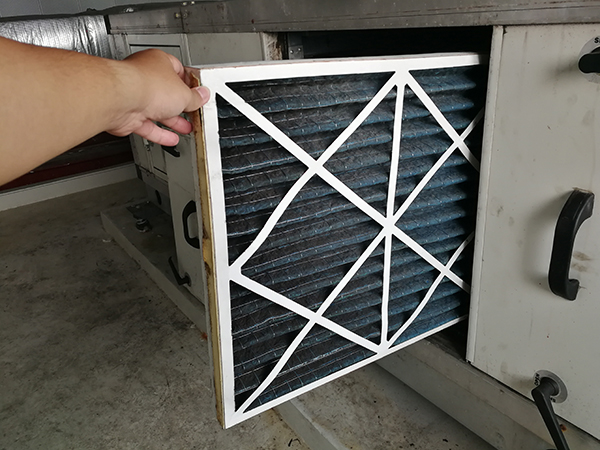How to Choose the Right HVAC Filter for Your System


Having quality air in your home is very important. Indoor air affects your health, productivity, safety, and comfort. It also impacts the overall performance of your HVAC system and other appliances and devices in your home. Although it’s true that your indoor air quality and airflow are affected by various factors in your home, your HVAC filters are the key players.
Therefore, your selection of the filters, and by extension, the HVAC system itself, will directly determine the quality of the air you breathe and the overall efficiency and health of your home’s climate control. This is why you must make an informed decision when replacing your HVAC filters.
The Role of HVAC Filters
Depending on your system type, the filters are either located behind the return air grille or near the blow compartment of the indoor unit. Their job is to trap airborne particles as air travels to the components that condition it. Take a furnace, for example; filters will remove pollutants in the air so that it is clean when it reaches the heat exchanger.
This design is important because air particles can damage the intricate inner parts of an HVAC system if they get through. For instance, dust accumulation on the heat exchanger acts as insulation, which causes the system to overheat, eventually leading to system failure.
In addition to protecting your HVAC system, filters also safeguard household members by removing mold spores, pollen, microorganisms, dust, debris, and other airborne contaminants from your indoor air. The result is improved respiratory health, enhanced cognitive function, better sleep quality, and fewer allergy and asthma symptoms.
How to Pick an HVAC Filter
If this is your first time replacing your air filters, be sure to give a qualified HVAC technician a call just to verify that everything you do in the steps below is appropriate for your system. Here are the key considerations.
Step 1: Know Your HVAC Filter Type
Residential HVAC systems use several types of filters. The common ones include fiberglass, pleated, HEPA, and electrostatic filters. Fiberglass filters are the most basic and affordable option, with the ability to trap larger particles like lint and dust. They are suitable for short-term use or environments with low air quality concerns.
Pleated filters provide a step up in effectiveness. They are made with densely woven synthetic or natural fibers. They also feature a folded design, which increases the surface area for particle capture. Pleated filters are the typical filters used in residential HVAC systems. They last longer and can trap most particles found in an average home.
HEPA (High-Efficiency Particulate Air) filters are the best option available. They can capture up to 99.97% of airborne particles, including smoke particles, viruses and bacteria, volatile organic compounds (VOCs), and pollen. They are so effective that hospitals and other critical facilities where air purity is paramount rely on them to maintain sterile or highly controlled environments.
Electrostatic air filters are also common in homes because they are reusable. When they accumulate significant particles, you simply wash them and insert them back into their slots. They can last up to five years or even longer with proper cleaning and maintenance.
To know the type of filter your system uses, check for labels or markings on the existing filter or refer to your HVAC manual. This information is crucial because it’s best for your HVAC system to use its recommended filter type.
Step 2. Understand Your Filter Size
For optimal filtration, a filter must fit snugly within its designated slot. Air will always try to find the path of least resistance when flowing. So, if there are gaps around the edges of the filter, it will bypass the densely woven fibers entirely. As a result, all dirt and debris present in your home will settle on fragile internal components of your HVAC system.
Filter dimensions are usually printed on the frame. Check your existing filter’s frame for size information. The reading should appear as 16″ x 24″ x 1″ (these are hypothetical values). The first number, 16, represents the length; the second number, 24, is the width; and the third, 1, indicates the thickness or depth of the filter. The (“) symbol stands for inches.
If the frame is missing or unreadable, consult the system’s manual or contact the manufacturer for specific details. You can also measure the length, width, and depth of the filter’s slot using a tape measure or ruler.
Again, make sure that the filters fit tightly. Sometimes, the slot has a margin of error (wiggle room) of ½ inch or more.
Step 3. Consider MERV Ratings
MERV (Minimum Efficiency Reporting Value) is a nationally recognized measuring system that rates filters based on their ability to catch airborne particles. The scale ranges from 1 to 20, with 20 being the most effective at trapping particles.
HVAC system manufacturers will recommend a suitable MERV range based on the system’s airflow capacity and design. Therefore, if your system’s manual specifies that you can install pleated filters with a MERV rating between 9 and 11, you should stick to filters within that range.
Exceeding the recommended rating in pursuit of extra filtration can lead to issues like restricted airflow, higher energy costs, and increased wear on system components. On the other hand, using a lower-rated filter may not effectively capture the pollutants your system is designed to handle, compromising indoor air quality and the unit itself.
Step 4. Brand Quality
All markets are flooded with real and counterfeit products, and the HVAC filter market is no exception. Don’t risk damaging your system by installing a knock-off filter. Do a thorough due diligence when buying a replacement.
To avoid counterfeits, either purchase your filters from authorized HVAC dealers or directly from your system’s manufacturer. Authorized HVAC parts sellers follow strict quality control measures, providing filters that meet manufacturers’ specifications.
If shopping online, again, stick to reputable sellers. Double-check product listings for inconsistencies in labeling, packaging, or pricing. Counterfeit filters tend to be suspiciously cheaper (when compared to market rates) and have poorly printed packaging, spelling errors, or faded logos. Also, be sure to read reviews, both positive and negative, to spot any red flags.
Signs Your Filter Needs Replacing
Experts recommend changing your filters every two to three months for peak system performance and indoor air quality. However, several factors can shorten or extend that timeline, including the following.
Household Size and Occupancy
The more people living in your home, the faster your filters are likely to get dirty. This is because more people mean more dust, VOCs (from fragrances), pollen, and other particles. More importantly, if there are household members with allergies or respiratory issues, consider filter changes every 20-45 days.
Overall Environment
If you live in a high-traffic urban area, near ongoing construction, or a region with poor air quality, your filters may become saturated with pollutants more quickly. Similarly, rural areas with high pollen counts or significant agricultural activity will also contribute to faster filter clogging. You may need to replace or wash your filter more frequently.
Contact Rosenberg Plumbing & Air for More Information
Filters may be a simple component, but they play a crucial role in the effectiveness, efficiency, and longevity of your HVAC system. This is why you should approach replacements with caution. If you’re in the San Antonio area, reach out to Rosenberg Plumbing & Air for expert guidance in selecting the right size, type, and MERV rating for your specific system.
Taking good care of your heating and cooling system is imperative. This includes changing your HVAC filters regularly and getting routine tune-ups. Call Rosenberg Plumbing & Air today to get quality AC maintenance services for your home in San Antonio.
Tags: HVAC Maintenance, HVAC Tips



